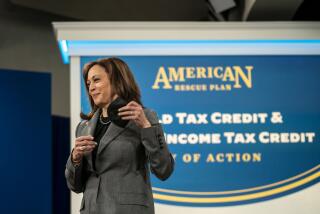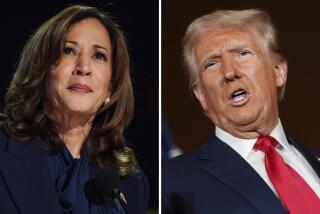How to Make the Flat Tax a Fair Tax : Forbes: His plan as it stands would benefit the rich and penalize the poor. Some simple adjustments would bring equity.
- Share via
Republican presidential candidate and multimillionaire Steve Forbes has proposed a flat tax that country club voters should gladly embrace. Forbes’ flat tax would reduce or eliminate the federal income tax for the very wealthy because capital gains, interest and dividends would be tax-free. His proposal would reduce federal tax revenues so much that up to 25% of social services relied on by the middle class and the poor could be wiped out.
While scrutiny and criticism of Forbes is increasing now that he has become a fast-rising challenger to Sen. Bob Dole, his tax concept is not all wrong. What is missing are the key ingredients needed to transform Forbes’ proposal into a fair flat tax. This can be accomplished without changing his basic 17% tax rate.
* Include all income as part of the tax base, including capital gains, interest and dividends, in order to avoid a bias in favor of the nonproductive heir who just clips bond coupons and follows the Dow Jones average.
* Avoid windfalls for the very wealthy and ensure a balanced budget by adding a 10% surcharge to all income above $250,000 (that is, a rate of 27% for all income above that amount), a proposal that would affect only one in 200 families.
* Ensure that the wealthy pay the same basic rate as the working poor by requiring that the entire Social Security tax rate (7.65%) apply to all wages, not just the first $62,000.
With these three simple changes, Forbes’ key concepts--a 17% basic rate, no deductions and no income tax on a family of four’s first $36,000 of income--could be preserved without producing a deficit or slashing social services or the defense budget. Under a fair Forbes flat tax, annual tax revenue would be neutral, the budget could be balanced and even a “typical” multimillionaire earning $10 million a year would have an effective tax rate of less than 27% (or a third lower than the existing top tax rate), while a family earning $60,000 would have an effective tax rate of less than 7% after taking into account the $36,000 tax exemption.
Three objections to these amendments are likely to be raised by Forbes, besides the tax increases that would be imposed on himself and other millionaires: The wealthy should be able to pay a far lower Social Security tax rate than the typical worker; unearned income is privileged income that should not be taxed; the 10-point surcharge on the income of the super-wealthy (top 0.5% of families) makes the flat tax too complex.
Our response is simple: All income up to $250,000 a year should be taxed equally and any sixth-grader can easily calculate the additional surcharge of 10% of all income above $250,000. However, we’re personally willing to provide an accountant to any millionaire who finds this too complex.
(BEGIN TEXT OF INFOBOX / INFOGRAPHIC)
Making Forbes Fair
The tax differences for a family of four between the Forbes Plan and a Fair Forbes Plan, under which the wealthy would contribute far more.
Income: $36,000 income, all salary
Forbes Plan Tax: 0
Fair Forbes Plan Tax: 0
*
Income: $60,000 income, all salary
Forbes Plan Tax: $4,080
Fair Forbes Plan Tax: $4,080
*
Income: $100,000, all salary
Forbes Plan Tax: $10,880
Fair Forbes Plan Tax: $13,280
*
Income: $500,000, half salary, half interest and captial gains
Forbes Plan Tax: $36,380
Fair Forbes Plan Tax: $115,280
*
Income: $1 million, 10% salary, 90% capital gains
Forbes Plan Tax: $10,880
Fair Forbes Plan Tax: $241,280
Source: The Greenining Institute
More to Read
Get the L.A. Times Politics newsletter
Deeply reported insights into legislation, politics and policy from Sacramento, Washington and beyond. In your inbox twice per week.
You may occasionally receive promotional content from the Los Angeles Times.










